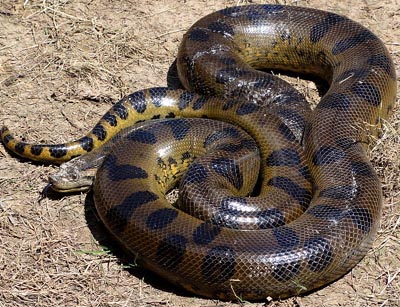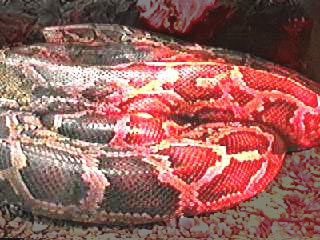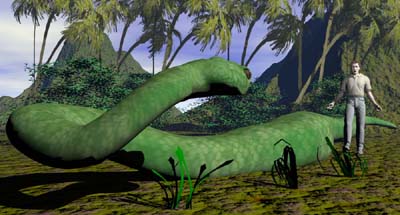pop up description layer
HOME
Cryptozoology UFO Mysteries Aviation Space & Time Dinosaurs Geology Archaeology Exploration 7 Wonders Surprising Science Troubled History Library Laboratory Attic Theater Store Index/Site Map Cyclorama
Search the Site: |
|
|
|
A large anaconda. (Copyright Dave Lonsdale licensed under the Creative Commons Attribution 2.0 Generic license.) |
Fawcett describes how they stopped and examined the body. Though he had no ruler, he guessed the length of the creature at sixty-two feet with a twelve-inch diameter. "Such large specimens as this may not be common, but the trails in the swamps reach a width of six feet and support the statements of Indians and rubber pickers that the anaconda sometimes reaches an incredible size dwarfing that shot by me. The Brazilian Boundary Commission told me of one exceeding eighty feet in length!"
Neither Fawcett's snake, nor the rumors heard by the Boundary Commission, count as a confirmed report, however. A petroleum geologist in eastern Columbia in the 1944 found an anaconda he measured at 37 1/2 feet in length. Most people do not accept this report because after shooting the snake and measuring it, the expedition went off and ate lunch before attempting to photograph and skin it. While they were gone, the snake, (apparently still alive) crawled or swam away. Vincent Roth, a scientist working in British Guiana claims to have shot a 34 foot specimen, but his story also lacked corroboration.
The Anaconda
The anaconda, or Eunectes murinus, lives in central and tropical South America. This monstrous snake can live in fresh water and could be a candidate for some smaller sea serpent or lake monster reports. Like all snakes, the anaconda is carnivorous. While some snakes use venom (poison) to kill or paralyze their victims, the anaconda, like its Eastern Hemisphere cousins, the pythons, kill by constriction. A constricting snake, loops its body around an animal and uses its powerful muscles to squeeze its victim until the animal can no longer inflate its lungs to breathe, causing suffocation.
|
Video Bonus: An anaconda finds its dinner. |
The anaconda is a member of the boa family of snakes and is dark green in color with round markings. It is sometimes referred to as the "water boa." Because the anaconda's weight is usually supported by liquid, it can grow heavier than snakes that make their homes in trees. The water-based anaconda often winds up drowning its victims as they are pulled under the surface rather than killing them by suffication..
Snakes swallow their victims whole. Although it is often said a snake's jaw can be unhinged from the skull to allow something much larger than the snake's mouth to be swallowed, the jaws are actually connected by a ligament that stretches. Once the carcass is inside the snake it must be digested quickly before it rots in the serpent's gut. If a snake cannot digest his prey before bacteria does, the snake will be forced to regurgitate it. If he cannot spit it out, the snake may die of food poisoning.
Large anacondas feed on deer, pigs, caiman (a creature that looks like a small crocodile), and fish. The snake usually wraps his extended jaws around the head of the victim and swallows, working its way down to the victim's feet. This allows the unfortunate animal's limbs to neatly fold inward rather than present an obstacle to ingestion.
.
|
A python coiled up for a rest under a sun lamp. |
The Python
While some consider the anaconda the largest snake, problems with the above claims cause many people to argue that a reticulated python (Python reticulated) killed in Celebes, Indonesia in 1912 deserved the prize as the longest single snake specimen. It was 32 feet, 10 inches long.
The python's natural range includes Africa, Asia and Australia. Though they are constrictors, as are their cousins the anaconda, most pythons species prefer trees to water. Their color varies between bright greens and muted browns, depending on which camouflage suits them best for their geographical region. While not native to North America, the Burmese python, Python molurus bivittatus, has become an invasive species in the Everglades National Park in Florida.
The average length of a python seems to exceed the average length of an anaconda. The anaconda, however, is foot per foot a much bigger snake than the python, being both heavier and wider in girth. This is probably because the anaconda, a water snake, does not have to be concerned about getting its body up a tree like the python does. Because of this perhaps the anaconda probably really deserves the title "largest snake."
Still a reticulated
|
Video Bonus: Hunting a giant python in India. |
python also takes the record for longest captive giant. The Pittsburgh Zoo's Colossus, a female captured in Thailand in 1949, measured 28½ feet long and weighted over 320 pounds.
Why is there such a controversy about which are the largest snakes? These creatures live in some of the wildest and most primitive parts of the world and it isn't always easy to confirm reports. Skins from dead snakes can be stretched making them seem larger than they were in life. Live snakes prefer a coiled position and often even a dozen men can't make them stretch out straight enough to be measured. Some stories are simply just exaggerations. In 2003 the world was excited by reports of a python 49 feet long and weighing 985 pounds living in a small zoo in Indonesia. When a correspondent from the British newspaper The Guardian was send out to measure the serpent firsthand, however, he found it was less than 21 feet long and only 220 pounds. A big snake in anybody's book, but not the record breaker that everyone was excited about.
Pre-historic Giant Snakes
|
In the words of one expert a human being encountering a Titanoboa cerrejonensis would "be toast immediately." (Copyright Lee Krystek, 2009) |
As big as the anacondas or the pythons are today, they are not nearly as large as the biggest snake that once slithered across the earth. The Titanoboa cerrejonensis ("ty-TAN-o-BO-ah sare-ah-HONE-en-siss"), which means "titanic boa from Cerrejon," grew to between 42 and 45 feet in length and weighed an estimated 2,500 pounds. The creature lived in the rain forests of Colombia between 58 million to 60 million years ago, dining on an ancient relative of crocodile. The girth of the creature at its widest was more than a yard. Standing next to it a man would find it coming up to his hip. Like the modern anaconda, Titanoboa spent most of its life in the water.
Because snakes are cold-blooded and depend on the temperature of their environment to keep them warm, scientists think that such a large snake suggests that the tropics of Columbia once were as much as 10 degrees warmer than they are today.
One snake expert, Jack Conrad of the American Museum of Natural History, commenting on Titanoboa said, "This thing weighs more than a bison and is longer than a city bus. It could easily eat something the size of a cow. A human would just be toast immediately."
People as Snake Prey
Do large modern snakes like the python and the anaconda eat people? Occasionally such attacks are recorded. In 1972 a python in Burma ate an eight-year-old boy. In 1927 there was a story about a jeweler named Maung Chit Chine. He hid under a tree during a rain storm and afterward his friends could only find his hat and shoes. When they killed a nearby gouged python, they found the rest of Chines' body, swallowed feet first (though this seems opposite to normal snake behavior) and whole, inside the snake.
Strangely enough, many big snakes attack humans not in the jungle, but in suburbia. Pythons are often kept as pets, but can turn deadly without warning. In 1993 in Colorado, a 15-year-old boy weighing 95 pounds was attacked by the family's python. The snake was only of medium size being 11 feet long and weighing 53 pounds, yet was able to kill the boy, though it made no attempt to eat him.
The beautiful skin patterns of pythons. Left is normal, while the right is an albino from the National Zoo who would not have survived in the wild as its coloration would have given it no protection when it was young. (Copyright Lee Krystek, 1998) |
Snakes make no concession to the rich or famous, either. Cartoonist Gary Larson of The Far Side fame had a close call with a Burmese python he had raised from a baby. According to Larson he realized he was "living with a gigantic predator with a very small brain" one day when it tried to do him in.
Big snakes, though beautiful and interesting, can be dangerous. And they don't have to be record holders or live in the jungle to kill.
![]() For more information about raising large snakes visit the
Pythons Net.
For more information about raising large snakes visit the
Pythons Net.
Copyright Lee Krystek 1996-20013. All Rights Reserved
|
Related Links |
|
|



 The
World's
The
World's 




